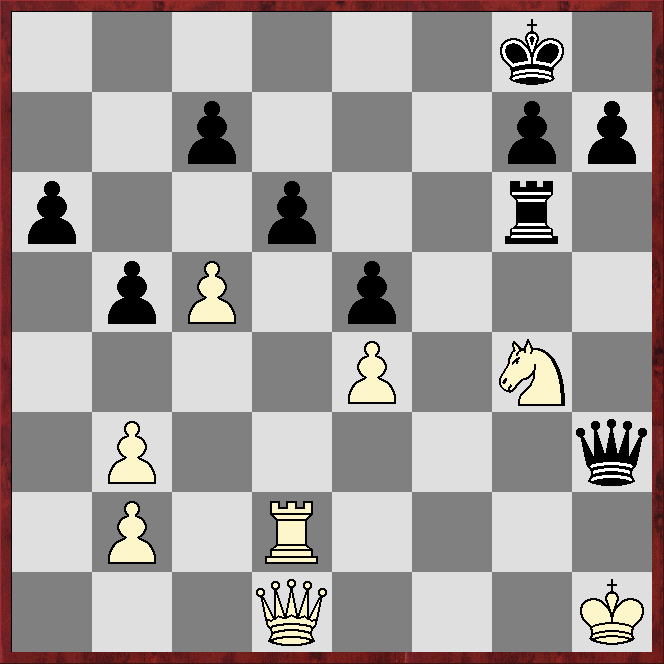Petrov
1.e4 e5 2.Nf3 Nf6 3.Nxe5 d6 4.Nf3 Nxe4 5.d3!? Nf6 6.d4 Be7!?
The main continuation, 6...d5, transposes to the Exchange Variation of the French: 1.e4 e6 2.d4 d5.3.exd5 exd5 4.Nf6 Nf6, albeit with two more pairs of moves played.
*****
*****
*****
*****
7.c4!?
Carlsen, Kasparov, Kramnik and So are among big names who have preferred 7.Bd3.
7...0-0 8.Bd3 c5!?
Probably a novelty, and possibly not a good one, although Stockfish16.1 and Dragon1 are OK with it.
9.d5 Re8 10.0-0
*****
*****
*****
*****
The most significant feature of the position is White's central space advantage, which confers a slight edge, according to the engines.
10...Bg4 11.h3 Bh5
The engines prefer 11...Bxf3!? 12.Qxf3 Nbd7.
12.Bf4 Bf8 13.Nbd2 Nbd7 14.g4!?
This is liked by the engines', along with 14.Qb3!?
14...Bg6 15.Bxg6 hxg6 16.Re1 Rxe1+ 17.Qxe1 b5!
This is the engines' top choice, although they still give White an edge.
18.b3 Qa5 19.Ne4
The engines suggest 19.Qc1!? or 19.Bh2!?
Qxe1+ 20.Rxe1 Nxe4 21.Rxe4
*****
*****
*****
*****
White has more space and the more-active pieces, but Black has annoying pressure against the white queenside. The engines reckon White has the better side of equality.
21...Nf6?!
But the engines dislike this, presumably because it does not help on the side of the board where Black is better. Instead they give 21...Nb6 22.Nd2 a5 with an initiative, eg 23.cxb5 a4! 24.Nc4 axb3! 25.axb3 Nxd5 26.Bxd6 Nc3 27.Re5 Nxb5 28.Bxf8 Kxf8 29.Rxc5 Nd4, claiming good compensation for a pawn.
22.Re3 Re8
Dragon1 suggests 22...b4, but awards White the upper hand. Stockfish16.1 gives 22...a5!? 23.g5 Nd7 (23...Nh5 24.Bh2), but also reckons White gets the upper hand, after 24.cxb5 or 24.Nd2.
23.Rxe8 Nxe8 24.cxb5!?
23.Rxe8 Nxe8 24.cxb5!?
Giving up the d5 pawn, and thus leaving Black with a potential protected passer, to create a farside pawn-majority.
24...Nc7 25.a4 Nxd5
*****
*****
*****
*****
No, as 26.a5?? Nxf4 27.b6 axb6 28.axb6 loses to 28...d5 etc, while 28.a6 loses to 28...Nd5 or 28...Ne6.
26.Be3 Be7
Not 26...Nxe3? as, after 27.fxe3, Black's bad bishop cannot cope with the white knight and queenside pawn-majority.
27.Kf1 Kf8 28.Ke2 Nb4?
This encourages White to play a move that was coming anyway, only now it comes with the gain of two tempi. On 28...Ke8, which is probably best, I planned 29.Bd2 and 30.Kd3, with what seem promising winning chances.
29.Bd2 Nd5
Forced.
30.Kd3 Ke8 31.Ng5 Nf6?!
Black can swop off the bad bishop, but the resulting bishop-v-knight ending seems winning for White. Perhaps best is 31...Nc7!?, although the engines reckon 32.h4!? is very strong, and other moves also leave Black in difficulties.
32.Ne4 d5!?
Other moves also lose.
33.Nc3 d4 34.Ne4 Nd7 35.f4 Nf6 36.Nxf6+ gxf6
Or 36...Bxf6 37.b4.
37.Kc4 Kd7 38.a5 g5 39.f5 Bd6 40.Bc1 Kc7 41.Bd2
It was still possible to go wrong, eg 41.Ba3 Kb7 42.Bxc5?? Bxc5 43.Kxc5 d3 etc.
41...Kd7 42.a6 Be7 43.b6 1-0

















































